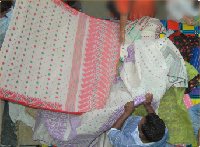
SOUTH
Asians have had a simple answer to Cinderella's fairy godmother for
a long time now, and this is the sari. It is amazing how a simple
piece of cloth measuring roughly 12 yards in length and requiring
no form of stitching can transform a woman into a symbol of femininity
and grace. Saris have been the attire of choice for our women folk
since ages ago, and are still reigning today for their ability to
bring out the best in a Bengali woman. These magic outfits come in
a wide range of fabrics and designs.
 Muslin
masterpieces
Muslin
masterpieces
Isn't it hard to imagine a fabric making a mighty Empire quake in
its boots? Well, that was the case with muslin saris during the Mughal
era. This fabric, which appeared sometime around 500 AD, reaching
the peak of its popularity sometime between the 15th and 16th centuries,
gets its name from Mosul, a place in Iraq where it was traded with
Europeans.
The
places near Dhaka such as Rupganj, Kapasia, Sonargaon, Junglebari
etc were well known for weaving high quality muslin. It is created
from the corpus cotton grown in Kapasia. The thread was so delicate
and soft that it had to be worked on in the early hours of the dew
laden morning. That way the moisture would keep the thread pliable
lest the heat and dryness of the afternoon caused it to snap. In fact
Dhaka was the source for some of the finest muslin pieces. The best
muslin saris are such that an entire outfit can be folded and tucked
into a matchbox. As a result it has taken pride of place as Dhakai
Muslin in the Victoria Albert Museum in England.
In
Dhaka the industry reached its height of glory during the Mughal era.
The royal women folk preferred to swathe themselves in the luxuriously
soft material. Nur Jahan and Mamtaz Mahal took full advantage in aiding
their beauty.
 When
the English took over the Subcontinent, they found this beautiful
material to be a threat to their own textile industries, which were
far inferior in quality, so it was off with the fingers for the weavers,
and thus the industry met a sad end.
When
the English took over the Subcontinent, they found this beautiful
material to be a threat to their own textile industries, which were
far inferior in quality, so it was off with the fingers for the weavers,
and thus the industry met a sad end.
The
present day muslin saris are a bit different in the sense that these
made with a different thread and in a different weaving process. This
work in mainly carried on at the Mirpur Benarasi Ward. The outfits
are gorgeous with heavy work, which determines the price. Mainly these
are worn during festivities and special occasions like weddings.
 Jamdani
journal
Jamdani
journal
Historians cannot exactly determine when jamdani came about but it
is well known that the descendants of the muslin weavers kept this
trade alive. Jamdani also needs climatic conditions for proper development.
It also requires a humid environment and that is why many weavers
set up their business alongside riverbanks. Its creation is different
from other fabrics in the sense that it does not use needles or the
jacquard process. The craftsmen use tiny wooden or bamboo spikes to
draw the intricate designs that consist of geometrical shapes.
It
is unthinkable for a Bengali woman not to have a jamdani sari in her
wardrobe. It is a classical piece that makes any woman stand out in
a crowd. Amazing designs can be found at Aarong, Mayasir, Nipun, Kumudinin,
Prabartana etc. Then there's the Hawkers Market, Mouchaak and New
Market. Of course, if you want alternative styles just head off straight
to Demra or Rupganj.
Hand
woven saris
 In a country where jamdani
and silk is only for the rich but not necessarily famous, hand woven
saris are the choice apparel for those on a budget. It has been in
use during the English rule when all else was considered a threat
to the English cloth industry. For both the weavers and the common
people this type of sari became their preferred material. Taat or
handloom materials have a rather heavy texture. These came in solid
colours or in simple designs known as Dhakai Biti and Pabna Biti.
Check and stripes were the prevalent patterns in a market that was
starting to become crowded with Indian and Pakistani brands.
In a country where jamdani
and silk is only for the rich but not necessarily famous, hand woven
saris are the choice apparel for those on a budget. It has been in
use during the English rule when all else was considered a threat
to the English cloth industry. For both the weavers and the common
people this type of sari became their preferred material. Taat or
handloom materials have a rather heavy texture. These came in solid
colours or in simple designs known as Dhakai Biti and Pabna Biti.
Check and stripes were the prevalent patterns in a market that was
starting to become crowded with Indian and Pakistani brands.
For
many years the women of this country were inclined towards buying
the foreign goods. During the eighties this trend began to reverse
with the help of some creative industrialists with new techniques
in weaving, design and bold new colour combinations. In many cases
golden and silver highlights are woven into the material to add a
glitzy touch. At present such saris are exported and a lot of this
credit goes to Monira Imdad who started the Tangail Sari Kutir in
Baily Road about two decades ago.
The
saris can be found at most of the shops in the city while a visit
to Babur Haat in Narsinghdi will take you directly to the heart of
the operation.
 Beautiful
Benarasi
Beautiful
Benarasi
A sari is a simple piece of cloth but the variations are countless
in the ways it can be worn or in its design and material construction.
Benarasi sari came about from the weavers of a locality by the same
name in India. They would create exquisitely detailed saris interwoven
with real gold or silver thread. Not surprisingly these would weigh
a lot -- around 10-15 kgs.
It
is a booming business in Mirpur where there are several thousand artisans.
It is a large area comprising of Mirpur roads 10, 11 and 12. New technology
has allowed fibres like rayon or synthetics to add texture and reduce
weight of the gorgeously designed katan and benarasi. Power looms
have made it a faster production process bringing the pricey items
within reach of the common people. Prices can range from 2000 to 50000
taka. It's a special sari that people use on special days. It's akin
to a dream outfit interspersed with the dreams and hopes of the weaver
with that of the wearer.
 People
used to go to India to shop for their wedding saris. While some still
do the tides are starting to change. Many now come over from abroad
to sample our offerings. The simple sari had its classical beginnings
from the muslin trough the humble handloom products till the present
day glamour pieces. It's style and elegance in a simple package.
People
used to go to India to shop for their wedding saris. While some still
do the tides are starting to change. Many now come over from abroad
to sample our offerings. The simple sari had its classical beginnings
from the muslin trough the humble handloom products till the present
day glamour pieces. It's style and elegance in a simple package.
By
Sultana Yasmin
Translated by Ehsanur Raza Ronny
sultry and sensuous:
the seduction of the sari…
WHEN we were merely
girls of seven or eight, my cousin Sonia and I used to love to imitate
our mothers in our games; their friendship, their love for life, their
laughter, their loving tantrums with our fathers, but mostly their
elegance and the stylish art of wearing saris. We were so fond of
this impersonation that we literally played wearing saris that were
hung on the clothes line in the huge open veranda at our grandmother's
house.
It was a real
comical scene. Half of the six yards of cloth was stuck on the line
by a wooden peg, while we pulled on the flowing half to create makeshift
aanchals, all the time standing under the sun, we two played 'bhabis'.
Oh, we also plaited the dupattas hanging around the line and wore
them on our heads to emulate braids. So much was our love for saris
and playing adults.
I guess all little
girls of Bengali mothers go through this phase at least once, because
interestingly my eight year old is demanding me to add few more to
her already existing sari wardrobe.
I think this fascinating
piece of cloth has this hypnotising effect on all of us sub-continental
girls. I remember this Jamdani walla who used to visit our mothers
with beautiful saris stacked in his canvas bag. What a festivity it
would be when he displayed each one with pride while the ladies went
crazy picking the ones they liked.
The sari has often
been described as 'the apparel that covers all...yet reveals all'.
What is it about this length of cloth wrapped around a woman's body
that adds so much allure? Visitors from distant kingdoms and empires
to this part of the globe since time immemorial have been tantalised
by bewitching women clad in saris.
Legend has it
that when the beauteous Draupadi, wife of the Pandavas, was lost to
the enemy clan in a gambling duel, the Lord Krishna promised to protect
her virtue. The lecherous victors, intent on "bagging" their
prize, caught one end of the diaphanous material that draped her so
demurely, yet seductively. They continued to pull and unravel, but
could reach no end. Virtue triumphed yet again in this 5,000-year-old
Indian epic, the Mahabharat.
Legend, fantasy,
history or fact, it is the first recorded reference to the enduringly
attractive sari - the longest, most popular style in the history of
women's fashion. The traditional six-yard sari, however, is a classic
and allows for generous pleating and draping around the body and over
the shoulder - almost Grecian in its elegance.
The basic draping
of a sari, the folding, tucking and pleating, beyond that, the sari
is a Bengali woman's statement to the world. It could be of shimmering
silk or the finest gauzy cotton. Perhaps a pastel-hued solid colour
or a riot of woven flowers. It may even be embroidered with golden
threads, or finished with a richly tasselled border.
It speaks of romance
or riches, of sobriety or gaiety, of sophistication or innocence.
Men are intrigued by the demure floor-length attire and tantalising
display of a bare midriff in the back. It is said that a sari rarely
fails to flatter a woman, making her feel fragile and feminine.
It is an instant
fashion, created by the hands of the wearer and subject to none of
the vagaries and changes that plague the fashions of the western world.
The success of the sari through all the centuries is attributed to
its total simplicity and practical comfort, combined with the sense
of luxury a woman experiences.
"The sari,
it is said, was born on the loom of a fanciful weaver. He dreamt of
woman. The shimmer of her tears. The cascade of her tumbling hair.
The colours of her many moods. The softness of her touch. All these
he wove together. He couldn't stop. He wove for many yards. And when
he was done, the story goes, he sat back and smiled and smiled and
smiled," narrates an ardent fan of the apparel.
Actually like
mentioned earlier the women love to wear saris because they saw their
mothers, grandmothers wearing it. It is this urge to replicate that
elegance for which women throughout the ages are passionate about
this apparel and this opinion was very enthusiastically seconded by
a lovely lady-Sadya Afreen Mallick.
"I love to
wear saris, it always makes me feel like dressing up, a bangle or
a bead necklace maybe, it always makes me feel and look graceful.
Remember our mothers used to wear glass nylon saris and had lovely
machine or hand embroidered petticoats with them? Often the petticoat
was more fancy then the sari itself, some even had cut work or chikan
material bordered by intricate laces. I mean those were style statements
made by the wearers themselves. They were their own designers,"
she recollects.
Young girls today
opt for shalwar kameez or jeans simply because they feel they don't
have the time to dress. After all they do lead high pace life today
than they used to in yesteryears. What they're missing out on, is
the unbeatable impression created by a cotton sari starched in aap
(a silver shimmer used when starching or washing a sari, a fashion
quite lost today), with beli phool in the braid. It's sheer enchantment,
one that even the most 'modern' madam isn't immune to. So why fight
the inevitable? Here's to losing oneself in the sensuous sorcery of
the sari.
By Raffat
Binte Rashid

